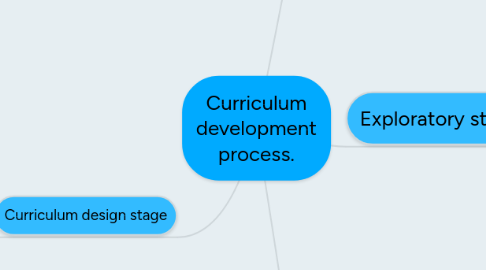
1. Curriculum design stage
1.1. Setting up a team of experts
1.1.1. To interprit the stated foundations
1.1.2. To make sound decisionson the nature of learning outcomes,content to be included, criteria assesments methods
1.1.3. Recommend teaching strategies and learning opportunities
1.1.4. Consists of
1.1.4.1. Experts in the field of education
1.1.4.2. Various subject desciplines
1.1.4.3. Expert clinical practitioners
1.2. Developing an educational plan and implementation guidelines.
1.2.1. The theoretical and clinical content that support achievement of the outcomes.
1.2.2. Content is organized and sequenced to reflect a curriculum organisation.
1.2.3. State teaching strategies and learning opportunities that would achieve outcomes.
1.2.4. Formulate criteria for assesment of learning.
1.2.4.1. Formulating outcomes
1.2.4.2. Selecting and organising curriculum content
1.2.4.2.1. Educational strategies, learning opportunities and assesment strategies should contribute towards learning experiences.
1.2.4.2.2. Curriculum content should have skills, intellectual processes, values and attitudes.
1.2.4.2.3. Subject matter corresponds to Blooms levels of knowledge and understanding.
1.2.4.2.4. Criteria for selecting content.
1.2.4.3. Organising and sequencing the curriculum content
1.2.4.3.1. Horizontal Articulation
1.2.4.3.2. Vertical Articulation
1.2.4.4. How curriculum content is learnt
1.2.4.5. Selecting teaching strategies and learning oppotunities
1.2.4.6. Developing Assesment methods and tools
1.3. Preparing for curriculum validation
1.3.1. Foundations of the curriculum
1.3.2. Curriculum rationale
1.3.3. Substance of the curriculum
1.4. Personnel development
1.4.1. Philosophy and theories that undelie the curriculum
1.4.2. Rtionale for the new curriculum
1.4.3. How to apply proposed teaching stratgeies and assist learners to utilise learning opportunities.
1.4.4. How learning assesment should occur
2. Curriculum Implentation
2.1. Curriculum is operationalised
2.2. Any teething problems are overcomed
2.3. the curriculum is evaluated informally on a continuous basis and corrections are made.
3. Monitoring and review stage
3.1. Curriculum evaluation is done in this stage.
3.2. A formal curriculum evaluation strategy is done
3.3. Evaluations and recommendations are documented
3.4. Recommendations formthe basis for a repeat of the entire curriculum development process.
4. Exploratory stage
4.1. Conducting a situation analysis
4.1.1. • The curriculum committee must determine the educational needsf
4.1.2. Conducting a market research
4.1.3. Ideas are obtained of the issues and trends that influence health
4.1.4. Technological innovations and trends have to be identified.
4.2. Identifying constraints
4.2.1. Identify possible contraints that will require creative strategies to overcome
4.2.1.1. Educators
4.2.1.1.1. Educator posts
4.2.1.1.2. Educators have diverse backgrounds
4.2.1.2. Learners
4.2.1.2.1. Learners must set some time to devote to each subject.
4.2.1.2.2. Existing knowledge, skills and relevant attituted may constrain curriculum development
4.2.1.3. Facilities
4.2.1.3.1. Provision of library and lab facilities may be inadequate.
4.2.1.3.2. The budget may be insuffiecient for extras you may need.
4.2.1.4. Other people's expectations
4.2.1.4.1. Statutory bodies impose certain requirements.
4.2.1.4.2. Potential employers have particular expectations which must be cateredfor.
4.3. Critical path analysis
4.3.1. which results in a working schedule according to which the curriculum committee will complete the various activities.
4.3.1.1. A critical path analysis identifies tasks to be completed and the deadlines for each task
4.3.1.2. We should start off by deciding on a date for the validation event:
4.3.1.3. We then work backwards from the date set for the validation event
4.3.1.4. The following are other deadlines that need to be included.
4.3.1.4.1. The first draft of the validation document
4.3.1.4.2. The internal validation event
4.3.1.4.3. The date for printing the document
4.4. Curriculum presage deliberations
4.4.1. Preconceived ideas
4.4.2. Consensus is reached about the meaning that will be attached to the concept of curriculum
4.4.3. Consensus is reached about the purpose of a curriculum in you proffession
4.4.4. Philosophical underpinnings.
4.5. Creating curriculum design criteria and plan of action
4.5.1. A blueprint is documented which includes.
4.5.1.1. The criteria that the new curriculum should adhere to.
4.5.1.2. Outlines activities to be completed
4.5.1.3. Foundations of the proposed curriculum
4.5.1.3.1. Mission, vision and philosophy
4.5.1.3.2. Underlying educational paradigm and philosophy
4.5.1.3.3. The learning theories on which the curriculum is based.
